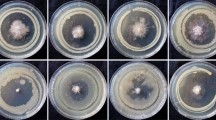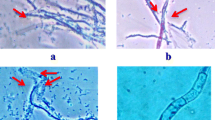Abstract
209 isolates of fluorescent pseudomonas, which showed antagonismin vitro againstRhizoctonia solani andPythium aphanidermatum, were investigated for their ability to influence the growth of cucumber. Among them 155 isolates showed a positive effect on the sproutweight of cucumber. Even 7Pseudonomas-isolates reduced the sproutweight between 20 and 50%. Eleven isolates caused an increase of 30 to 50% of the sproutweight as compared with the untreated control.
Zusammenfassung
209 Isolate von fluoreszierenden Pseudomonaden, die sich als Antagonistenin vitro gegenüberRhizoctonia solani undPythium aphanidermatum erwiesen haben, wurden hinsichtlich ihrer Wachstumsbeeinflussung bei Gurken untersucht. Von diesen Isolaten hatten 155 einen positiven Einfluß auf das Sproßgewicht. SiebenPseudomonas-Isolate reduzierten das Sproßgewicht zwischen 20 und 50%, 11 Isolate verursachten eine Sproßgewichtszunahme von 30 bis 50%, verglichen mit der unbehandelten Kontrolle.
Similar content being viewed by others
Literaturverzeichnis
Broadbent, P., K. F. Baker, Y. Waterworth (1971): Bacteria and actinomycetes antagonistic to fungal root pathogens in australien soils. Aust. J. Biol. Sci.24, 975.
Brown, M. E. (1972): Plant growth substances produced by microorganisms of soil and rhizosphere. J. appl. Bacteriol.35, 443–451.
Brown, M. E., J. E. Beringer (1983): The potential of antagonists for fungal control. Agric. Ecosyst. and Envir.10, 127–141.
Brown, M. E., S. K. Burlington (1968): Production of plant growth substances byAzotobacter chroococcum. J. Gen. Microbiol.53, 135–144.
Chakraborty, U., R. P. Purkayastha (1984): Role of rhizobitoxine in protection soybean roots fromMacrophominia phaseolina infection. Can. J. Microbiol.30, 285–289.
Eklund, E. (1970): Secondary effects of some pseudomonads in the rhizoplane of peat grown cucumber plants. Acta Agric. Scand. Suppl.17, 1–57.
Gerhardson, B., S. Alstrom, B. Ramert (1985): Plant reactions to inoculations of roots with fungi and bacteria. Phytapathol. Z.114, 108–117.
Gill, P. R., G. J. Warren (1988): An iron-antagonized fungistatic agent that is not required for iron assimilation from a fluorescent rhizoshere pseudomonad. J. Bacteriol.170, 163–170.
Hata, K. (1962): Studies on plant growth accelerating substances. Part I. The isolation method of soil microbes which produce plant growth accelerating substances.. Agric. Biol. Chem.26, 278–287.
Hussain, A., V. Vancura (1970): Formation of biologically active substances by rhizosphere bacteria and their effect on plant growth. Folia Microbiol. Prague11, 468–478.
Kerr, A. (1972): Biological control of crown gall: seed inoculation. J. Appl. Bacteriol.35, 493–497.
King, E., M. K. Ward, D. E. Raney (1954): Two simple media for the demonstration of pyocanin and fluorescin. J. Lab. Clin Med.44, 301–307.
Kloepper, J. W., D. J. Hume, F. M. Scher, C. Singleton, B. Tipping, M. Laliberte, T. Frauley, C. Kuutchaw, C. Simonson, R. Lifshitz, I. Zaleska, L. Lee (1988): Plant growth-promoting rhizobacteria on canola (rapeseed). Plant Dis.72, 42–46.
Kloepper, J. W., M. N. Schroth (1978): Plant growth-promoting rhizobacteria on radishes. Proc. 4th Int. Conf. Plant Path. Bacteria2, 879–882.
Kloepper, J. W., M. N. Schroth, T. D. Miller (1980): Effects of rhizosphere colonization by plant growth-promoting rhizobacteria on potato plant development and yield. Phytopathol.70, 1078–1082.
Lippert, E., P. Silhengst (1970): Interactions between plants and epiphytic bacteria regarding their auxin metabolism VIII. Transfer of 14C-indoleacetic acid from epiphytic bacteria to corn coleoptiles. Physiol. Plant23, 480–487.
Merriman, J. M., R. D. Price, J. F. Kollmorgan, T. Piggott, E. H. Ridge (1974): Effect of seed inoculation withBacillus subtilis andStreptomyces griseus on growth of cereals and carrots. Aust. J. Agric. Res.25, 219–226.
Michael, A. H., P. E. Nelson (1972): Antagonistic effect of soil bacteria onFusarium roseum ‘culmorum’ from carnation. Phytopathol.62, 1053–1056.
Schippers, B. (1983): Prospects of biological control of plant pathogens with fluorescentPseudomonas spp. Proc. 10th Int. Congr. Pl. Prot., 767–771.
Sneh, B. (1981): Use of rhizosphere chitinolytic bacteria for biological control ofFusarium oxysporum F. sp.dianthi in carnation. Phytopathol Z.100, 251–256.
Suslow, T. V. (1980): Increased growth and yield of sugar beets by seed treatment with selectedPseudomonas spp. and bacterial culture preservation in frozen or dry film of cellulose methyl ether. Ph. D. thesis, Uni. of California, Berkely.
Suslow, T. V., J. Kloepper, M. N. Schroth, T. Burr (1979): Beneficial bacteria enhance plant growth. Calif Agric.33, 15–17.
Suslow, T. V., M. N. Schroth (1982a): Role of deleteriius rhizobacteria as minor pathogens in reducing crop growth. Phytopathol.72, 111–115.
Suslow, T. V., M. N. Schroth (1982b): Rhizobacteria of sugarbeets: Effects of seed application and root colonization on yield. Phytopathol.72, 199–206.
Thomashow, L. S., D. H. Weller (1988): Role of a phenazine antibiotic fromPseudomonas fluorescens in biological control ofGaeumannomyces graminis var.tritici. J. Bacteriol.170, 3499–3508.
Thomashow, L. S., D. M. Weller, R. F. Bonsall, L. S. Pierson (1990): Production of the antibiotic phenazine-1-carboxylic acid by fluorescentPseudomonas spp. in the rhizosphere of wheat. Appl. Environ. Microbiol.56, 908–912.
Voisard, C., C. Keel, D. Haas, G. Defago (1989): Cyanide production byPseudomonas fluorescens helps suppress black root of tobacco under gnotobiotic conditions. EMO J.8, 351–358.
Werner D. (1987): Pflanzliche und mikrobielle Symbiosen. Stuttgart/New York: G. Thieme Verlag.
Wölk, M., S. Sarkar (1993a): Antagonismusin vitro von fluoreszierenden Pseudomonaden gegenüberRhizoctonia solani undPythium aphanidermatum. Zentralbl. Mikrobiol.148, 237–245.
Wölk, M., S. Sarkar (1994b): Antagonismusin vitro vonBacillus spp. gegenüberRhizoctonia solani undPythium spp. Anz. Schädlingskde., Pflanzenschutz, Umweltschutz. 1994;67:1–5.
Wölk, M., S. Sarkar (1993c): Ein verbessertes Selektivmedium zur Isolation von fluoreszierenden Pseudomonaden. Zentralbl. Mikrobiol148, 88–94.
Yuen, G. Y., M. N. Schroth, A. H. McCain. (1985): Reduction ofFusarium wilt of carnations with suppressive soils and antagonistic bacteria. Plant Dis69, 1071–1075.
Author information
Authors and Affiliations
Additional information
Mit 1 Abbildung
Rights and permissions
About this article
Cite this article
Wölk, M., Sarkar, S. Growth-promoting-Effekt von einigen fluoreszierendenPseudomonas-Isolaten auf Gurken (Cucumis sativus). Anz. Schadlingskde., Pflanzenschutz, Umweltschutz 67, 101–103 (1994). https://doi.org/10.1007/BF01904699
Issue Date:
DOI: https://doi.org/10.1007/BF01904699




